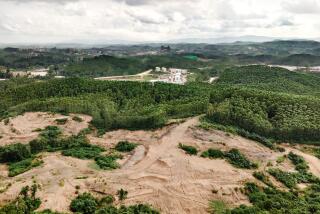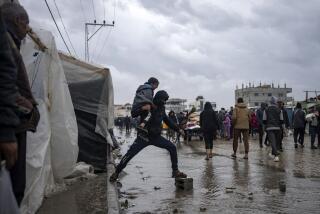An Existence Poised to Crumble
- Share via
BAWURAN, Indonesia — His village is a huge pile of rubble today, and for Sopo Nyono the reason seems simple: bricks without mortar.
For years, people on this part of Java island built their houses by piling bricks on top of one another with only layers of dirt between. There was no mortar or reinforcing bars, just a coating of concrete to keep the stack from toppling over.
When a magnitude 6.3 earthquake struck central Java on Saturday, hundreds, perhaps thousands, of these buildings turned into tombs. The death toll from the quake soared past 4,300 Sunday as troops and volunteers pulled bodies from the ruins. President Susilo Bambang Yudhoyono declared a state of emergency.
The government had put the toll higher than 5,000, but then lowered it after revising figures for the hard-hit district of Klaten, an official said.
Searchers said the quake claimed a disproportionately large number of impoverished residents because they were the ones most likely to live in the cheap, mortarless homes.
“Everything was destroyed, totally,” said Nyono, the treasurer of Bawuran village. “Most people who died were those who couldn’t move fast, the children and the old people.”
As rescuers completed a second day of combing through the rubble brick by brick, the chance of finding survivors dwindled. Workers said it seemed unlikely that anyone could have survived for more than a short time under the piles of brick and dirt, which would have left few pockets of air.
“We are still hoping that perhaps there are survivors,” said Ady Toyibi, who was leading a squad of volunteer searchers in Bawuran. “But when we check the sites, we can’t hear any sound of people screaming or crying. There is no sound at all.”
The quake struck at dawn near the ancient city of Yogyakarta. It caused extensive damage to carved stone reliefs at the ancient Hindu temple of Prambanan, one of the area’s major tourist attractions.
Authorities said two-thirds of the quake’s dead lived in Bantul, the densely populated area south of Yogyakarta where the mortarless style of construction is common.
Among the neighborhoods that make up Bantul is the village of Bawuran, where survivors were camping by the roadside and burning lumber from their ruined homes to cook meals.
The main street was a kaleidoscope of debris: bricks, roof tiles, clothing, mattresses, household appliances, window frames, bits of food and countless other items in a massive jumble. The facade of one building stood with its door open to a scene of ruin. A glass cabinet with stuffed animals sat bizarrely intact inside what had been a one-story house.
The mosque, once the village’s grandest and sturdiest building, was still standing but had suffered heavy damage. Its second story was leaning to one side and appeared in danger of falling over in an aftershock.
Of 2,000 people who lived in Bawuran, 54 were killed and 375 were injured, Nyono said. At least half the homes, including his, had been built all or partly without mortar and collapsed in an instant, he said.
The survivors escaped by running outside the moment the quake struck. Few left with anything more than the clothes on their backs, said Nyono, 54. He carried a donated blue toothbrush in his shirt pocket. It was one of his few possessions.
About 90 army and police troops and 35 volunteers from the Indonesia Federation of Speleology, an association of cave explorers, combed through the village Sunday and found five bodies. In the first hours after the quake Saturday, they pulled 43 villagers from the debris. The searchers said they would resume the effort today to find six people who are believed dead.
Cahyo Alkandana, a documentary filmmaker and president of the cavers group who was coordinating the volunteer search, said construction quality was a key factor in the deaths.
“Poor people were more likely to die,” he said. “The high number of people killed is because of the quality of the houses. The good, new buildings did not collapse, but this model is going to collapse because it’s cheap.”
Alkandana, 40, said he and his crew were filming inside a nearby cave when the earthquake struck. Rocks began raining from the roof, and they feared they would be buried alive. But they soon made their way out.
Learning of the magnitude of the disaster by radio, they immediately joined the rescue effort in Bawuran. The volunteers from his group, mostly university students, removed bricks by hand as they looked for bodies.
Nearby, residents salvaged a few pots and pieces of clothing and built shelters of plastic sheeting and corrugated metal roofing. They said they had received little help from outside and estimated that they had about two days’ worth of food. They had been coping with dozens of aftershocks and frequent rain, they said.
“Please inform people that we need help here,” said Bagiono, a retired Navy sergeant who, like many Indonesians, goes by one name. “We need food. We need shelter.”
Bagiono said he did not believe anyone buried in the village could still be alive. “It’s been two days already. I don’t think anyone has a chance to survive.”
More to Read
Sign up for Essential California
The most important California stories and recommendations in your inbox every morning.
You may occasionally receive promotional content from the Los Angeles Times.










